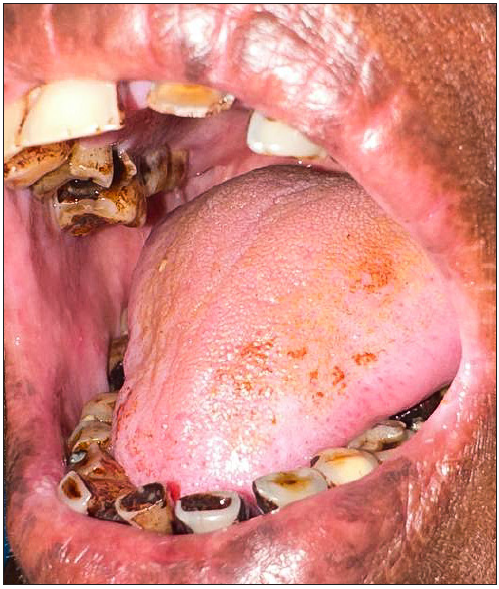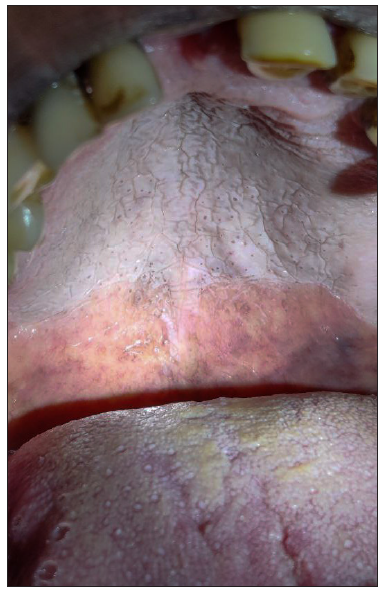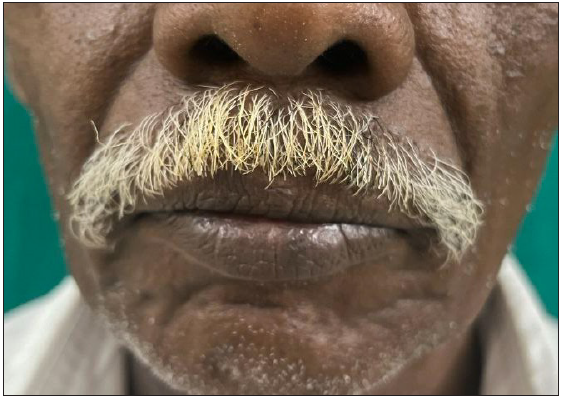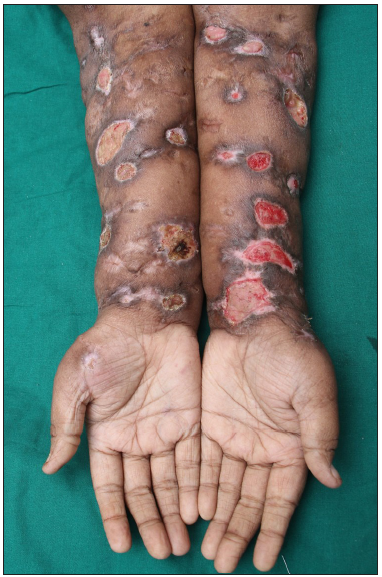Translate this page into:
Signs and terminologies in cutaneous manifestations of substance abuse
Corresponding author: Dr. Aravind Sivakumar, Department of Dermatology, Jawaharlal Institute of Postgraduate Medical Education and Research (JIPMER), Gorimedu, Pondicherry, India. aravinddermat@gmail.com
-
Received: ,
Accepted: ,
How to cite this article: Murugan K, Sivakumar A. Signs and terminologies in cutaneous manifestations of substance abuse. Indian J Dermatol Venereol Leprol. 2024;90:682-6. doi: 10.25259/IJDVL_821_2023
Substance abuse is defined as “when the patient continues to abuse a drug despite it causing physical and mental harm.”1 The Diagnostic and Statistical Manual of Mental Disorders (DSM-V) classifies substance use disorder as occurring in individuals consuming drugs, resulting in impaired control, physical dependence, social problems and risky use. Commonly abused agents include cocaine, heroin, cannabis, opioids, alcohol and tobacco in any form. It is of particular importance for the dermatologist as these individuals are at increased risk for developing sexually transmitted infections, skin and soft tissue as well as other blood-borne infections. This behaviour can also complicate commonly occurring dermatoses such as psoriasis, acne, hidradenitis suppurativa and lupus erythematosus. Hence, understanding the signs and terminologies underlying these groups of dermatoses is important.
Terminologies related to substance abuse
Knowledge of slang and other lesser used terminologies concerning substance abuse will enable the dermatologist to identify the nature and type of drug usage [Table 1].
| S. No | Terminology | Description |
|---|---|---|
| 1. | Bath salts | These are central nervous system (CNS) stimulants similar to methylenedioxymethamphetamine (MDMA) or Ecstasy derived from plant-based cathinones and used via various routes.2 |
| 2. | Bazooka | Bazooka refers to the mixture of crack cocaine with marijuana which is smoked. |
| 3 | Basuco | Not to be confused with Basuco which means “the dirty trash of cocaine” in Spanish, referring to the residual paste left over during cocaine production with psychoactive properties which can be abused.3 |
| 4. | Black tar | Black tar or black dragon is an impure cheaper derivative of heroin unlike white or brown heroin, produced mainly in Latin America and Mexico.4 |
| 5. | Body packer | ‘Body packers’ are persons who, voluntarily or forcibly, swallow drug packets usually heroin or cocaine in large amounts into the body cavity, for illegal transportation across international borders.5 |
| 6. | Body stuffer | ‘Body stuffers’ are persons who swallow only small amounts of drugs, unlike body packers, for immediate disposal.5 |
| 7. | Booting | Booting is when the drug user repeatedly draws blood from the vein into the drug-filled syringe and then flushes it back into the vein thus increasing the risk for infections and thrombophlebitis.6 |
| 8. | Chemsex | Usage of chemical substances immediately before or during intercourse to intensify, facilitate, and/or prolong sexual experience. Used mainly by men who have sex with men. Substances used include mephedrone, methamphetamine, ketamine and gamma-hydroxybutyrate).7,8 |
| 9. | Shotgunning | Inhalation of smoke and exhalation into the mouth of others is called shotgunning. It increases the chances of respiratory infections.9 |
| 10. | Speedball | It is a combination of cocaine with heroin injected intravenously among IV drug abusers.10 |
Cutaneous manifestations of substance abuse
-
A.
Cannabis/Marijuana
Cannabis arteritis: Chronic marijuana smokers develop progressive claudication, Raynaud’s phenomenon leading to acral ischaemia, gangrene and amputation. It occurs directly due to the vasoconstrictive effects of Δ9-tetrahydrocannabinol because of adrenergic stimulation and inhibition of nitric oxide synthase. It closely mimics Buerger’s disease from which it can be distinguished by duplex ultrasound or arteriography which shows poorly developed arterial collaterals in Buerger’s disease. Associated nail changes are splinter haemorrhages, Beau’s lines, onychorrhexis, onycholysis and nail plate pigmentation, eventually leading to nail plate loss. Early-stage disease can be halted by smoking cessation and vasodilators; in late stages, gangrene requires amputation.11,12
-
B.
Betel Quid
Betel Chewer’s mucosa: ‘Betel chewer’s mucosa (BCM)’ appears as irregular rough macerated mucosa with areas of desquamation and reddish-brown discolouration [Figure 1]. This is due to calcium hydroxide and polyphenols combined with nicotine from tobacco which polymerises on contact with mucosa and cannot be easily removed.13
 Figure 1:
Figure 1:- Chewers mucosa due to long-term betel quid chewing.
-
C.
Tobacco:
Chingari sign: The clothes of bidi smokers have numerous holes due to sparks. Biri is tobacco rolled in Tendu leaves and is one of the most prevalent forms of smoking in India.14
Harlequin nails/quitters’ nails: It is characterised by a demarcation line between the newly developed proximal pink nail and the distal yellowish pigmented nail that occurs after the sudden cessation of smoking.15
Smokers’ palate/smokers’ keratosis: It is also known as ‘nicotine stomatitis’ or ‘leukokeratosis nicotina palati’. It is characterised by greyish-white colouration of the palatal mucosa studded with red punctate papules in smokers16 [Figure 2].
 Figure 2:
Figure 2:- Greyish white palate studded with multiple red dots in chronic tobacco usage.
Smoker’s tongue: It is also known as ‘leukokeratosis nicotina glossi’. It is characterised by pin-point pinkish hemispherical depressions in smokers.14,15
Smokers’ melanosis: It is the melanin pigmentation of the gingiva secondary to smoking.14,16
Smoker’s face: A plethoric face with prominent wrinkles and furrows radiating at right angles from corners of the mouth and eyes, cheeks and lower jaw revealing underlying bony contours.14,16
Smokers’ moustache: It is seen in heavy smokers and characterised by yellowish-brown discolouration of grey or white hair of the moustache14,16 [Figure 3].
 Figure 3:
Figure 3:- Yellowish discoloration of the moustache in smokers.
Smokers’ comedones: It is seen in heavy smokers. It has multiple large open and closed comedones with furrows and nodules resembling that of Favre–Racouchot syndrome.14,16
Smokers callosity: Smoking is associated with increased chances of developing painful plantar callosities or corn. It is due to the direct vasoconstrictive action of nicotine and increased free radical formation causing damage to the connective tissue framework of the skin. Frictional callosities of the dominant thumb in smokers are called cigarette lighters’ thumbs.17
Snuff dippers lesions: Mainly seen in smokers, also known as ‘smokeless tobacco keratosis’ or ‘tobacco pouch keratosis’. It is characterised by a whitish lesion in the oral cavity where smokeless tobacco is held.16
-
D.
Cocaine:
Cocaine bugs: Formication or delusional parasitosis or cocaine bugs are seen in cocaine users. It is the tactile hallucination of insects crawling underneath the skin.18
Cocaine-induced midline destructive lesions (CIMDL): Cocaine induced midline destructive lesions (CIMDL) presents with clinical features of systemic disease, with positive anti neutrophil cytoplasmic antibodies (ANCA) and endoscopic, radiological and histopathological abnormalities in the nasal septum and turbinate. They present with long-standing symptoms such as diffuse necrotising ulcerative lesions, septal perforation, extensive crusting, epistaxis and less commonly hard and soft palate perforation.18
Cocaine keratosis: Refers to the whitish adherent membrane formed at the gingival margins because of repeated rubbing which leaves raw erosions on removal progressing to gingival recession and ulcerative gingivitis.19
Parrot Beak nails: It refers to the forward overcurvature of nails that occurs in cocaine abuse. The triad of digital pulp atrophy, parrot beak nails and perniosis strongly suggest crack cocaine usage, which is the pure form of cocaine taken via inhalational route. These are mainly attributed to the vasculopathy causing digital ischemia and necrosis. Differentials include pachyonychia congenita and onychogryphosis where the nail appears thickened in addition to the over curvature seen and clubbing where the proximal nail fold and nail bed angle are blunted by Schamroth window testing. These changes are often reversible after cessation of cocaine usage.20
Formication: It is a tactile hallucination characterised by an insect crawling sensation beneath the skin secondary to cocaine (cocaine bugs) and methamphetamine (meth mouth).9,10 It results in excoriations and prurigo-like lesions.19
Gummies: Oral use of cocaine abuse causes erosion of dental enamel and poor dentition.18
Pseudovasculitis: Seen in cocaine abusers due to its vasoconstrictive effects, occurring due to irritation by adulterants or by infections secondary to trauma. It presents as extensive nasal destruction mimicking midline lethal granulomas with false-positive ANCA antibodies.21
Levamisole purpura: Levamisole is an adulterant added to cocaine to increase its dopamine levels and potency. It characteristically results in retiform purpura affecting the auricles, nose and face. The mechanism proposed for this is that it serves as a substrate for myeloperoxidase and forms reactive metabolites that activate autoimmunity.19 It resolves within 2–14 months of stoppage of levamisole.22
Matchbox sign: The patient collects skin debris with the mistaken belief that it contains an alleged parasite in a matchbox, tissue paper or small container called a matchbox sign or specimen sign. It can be seen in primary forms of delusional parasitosis (Morgellon disease) or secondary to underlying causes such as drug-induced formication because of heroin, amphetamine or cannabis.23
Snorters’ warts: They are seen in drug users who develop intranasal verruca due to snorting cocaine with the help of rolled dollar bills that aid in the transmission of human papillomavirus.19
-
E.
MDMA (Methylenedioxymethamphetamine/Ecstasy):
Ecstasy pimples: Ecstasy use results in euphoria, feelings of intimacy and enhancement of body sensation. The main ingredient is MDMA. It presents as an acneiform eruption consisting of papules and pustules over the face without comedones resembling perioral dermatitis.24
-
F.
-
G.
Pentazocine:
Pentazocine ulcers: Pentazocine is a cheap analgesic drug that is commonly used off-label, resulting in drug dependence. It is mostly prescribed by quacks as repeated intramuscular injections which on prolonged administration leads to difficult venous access and hence sclerosis, fibrosis and ulceration of the underlying tissues. These ulcers are usually irregular in shape surrounded by a hyperpigmented halo and tense woody expansive fibrosis following the course of superficial veins eventually leading to puffy hand syndrome [Figure 4]. The mechanisms underlying these ulcers include vasoconstriction with tissue ischaemia at injection sites, trauma due to repeated injections and precipitated pentazocine in tissues causing inflammation.26
 Figure 4:
Figure 4:- Multiple shallow irregular ulcers with surrounding hyperpigmentation and woody fibrosis.
-
H.
Heroin (Injectional drug usage):
High pruritus: It refers to the intense itchiness over genitalia and face experienced during the high induced by heroin usage. In a study done in Kashmir, India, pruritus was found to be the most common side effect among drug abuse patients mainly injectional drug usage with heroin.27
Pseudoacanthosis nigricans: It is the velvety hyperpigmentation of the axilla resembling acanthosis nigricans seen in heroin abusers.28
Puffy hands syndrome: It is a sign of current or past drug addiction and often occurs in injectional drug users (IDU) due to the toxicity of heroin or its irritant derivatives (Talc, flour, quinine, etc.), resulting in destruction of the lymphatics.10,24 The risk factors include female gender, subcutaneous injection over hands or feet and the lack of tourniquet use.24 It is characterised by non-pitting oedema of the back of the hands and loss of visibility of tendons and veins of the dorsum of the hand.24,28
Railroad tracks: In IDU, repeated intravenous injections leading to repeated venous thrombosis and subsequent fibrosis cause a linear cord-like thickening appearing as railroad tracks which are often pathognomonic of IDU.24,28
Skin popping: In case of difficult venous access, direct intradermal injection minimises the risk of drug overdose, enables ease of administration and causes a prolonged drug effect- referred to as skin popping. This can lead to chronic non-healing ulcers, secondary infection, abscess, wound botulism, necrotising fasciitis, tetanus, scar, hyperpigmentation, cutaneous granulomas, necrosis of digits (cocaine) and AA Amyloidosis, resulting in renal impairment.24,28
Shooter’s patch: These are chronic non-healing ulcers with exuberant granulation tissue with rich vascular supply thus enabling the drug user to inject directly into these areas occurring as a complication of skin popping.28
Shooting tattoos: It is caused by cooking the drugs, flaming the needles and then injecting its carbon and shooting into the dermis. Often users tend to cover these sites with commercial tattoos.28
Track marks: Repeated intravenous injections in chronic drug users result in scarring of veins with overlying hyperpigmentation due to the usage of blunt needles, irritants or adulterants. The most common site is the medial vein of the cubital fossa of the non-dominant hand followed by the popliteal fossa, inguinal veins and dorsal veins of the feet.24,28
Torniquet hyperpigmentation: It occurs after the application of various types of tourniquets such as shoelaces and belts which are very tight fitting and left for prolonged periods. It results in localised inflammation and post-inflammatory hyperpigmentation.24,28
-
I.
Desomorphine (Krokodil)
Desomorphine, also known as ‘krokodil’ or ‘drug that eats junkies’, is an opioid analogue. Intravenous injection leads to thrombophlebitis, ulcers, abscess, gangrene and skin necrosis eventually leading to scaly greenish-black discolouration of the skin resembling crocodile skin, hence its name (Russian: Krokodil).25
-
J.
Barbiturates
Coma blisters: These are the self-limiting blisters that usually occur within 24–48 h in pressure-bearing areas in neurological diseases and barbiturate overdosage. Occurs due to direct cutaneous toxicity, shock and vasoactive drugs causing low blood flow and uninterrupted pressure due to immobility.29
-
K.
Inhalant abuse:
Glue sniffers Rash: Toluene is the main component of volatile glues, aerosol paints and lacquer thinners that are abused by sniffing which stimulates the CNS via the Gamma amino butyric acid (GABA) dopaminergic pathway. Mucocutaneous effects include spots or sores in or around the mouth and severe dryness of skin and mucous membranes with secondary pyodermas known as ‘Huffer’s rash’.30
Declaration of patient consent
The authors certify that they have obtained all appropriate patient consent.
Financial support and sponsorship
Nil.
Conflicts of interest
There are no conflicts of interest.
Use of artificial intelligence (AI)-assisted technology for manuscript preparation
The authors confirm that there was no use of artificial intelligence (AI)-assisted technology for assisting in the writing or editing of the manuscript and no images were manipulated using AI.
References
- Substance Abuse. In: Walker HK, Hall WD, Hurst JW, eds. Clinical methods: The history, physical, and laboratory examinations (3rd edition). Boston: Butterworths; 1990. Chapter 206. [last accessed: Oct 23 2024]. https://www.ncbi.nlm.nih.gov/books/NBK319/
- [Google Scholar]
- Heroin in brown, black and white: Structural factors and medical consequences in the US heroin market. Int J Drug Policy. 2009;20:277-82.
- [CrossRef] [PubMed] [PubMed Central] [Google Scholar]
- Body-Packer & Body-Stuffer - eine medizinische Herausforderung [Body-packer & body-stuffer - a medical challenge] Praxis (Bern 1994).. 2010;99:533-44.
- [CrossRef] [PubMed] [Google Scholar]
- HIV risk behavior in drug users: Increased blood “booting” during cocaine injection. AIDS Educ Prev Off Publ Int Soc AIDS Educ. 1992;4:95-107.
- [Google Scholar]
- Chemsex and mental health of men who have sex with men in germany. Front Psychiatry.. 2020;11:542301.
- [CrossRef] [PubMed] [PubMed Central] [Google Scholar]
- “Shotgunning” in a population of patients with severe mental illness and comorbid substance use disorders. Am J Addict. 2012;21:120-5.
- [CrossRef] [PubMed] [PubMed Central] [Google Scholar]
- Cutaneous manifestations of injectable drug use: Hidden secrets. Cutis. 2014;93:185-7.
- [PubMed] [Google Scholar]
- Cannabis arteritis: ever more important to consider. BMJ Case Rep.. 2017;2017:bcr2016219111. doi: 10.1136/bcr-2016-219111
- [CrossRef] [PubMed] [PubMed Central] [Google Scholar]
- Raynaud’s phenomenon and splinter hemorrhage: An early telltale sign of cannabis arteritis. Int J Dermatol. 2022;61:e480-3.
- [CrossRef] [PubMed] [Google Scholar]
- Betel chewer’s mucosa--a review. J Oral Pathol Med.. 1998;27:239-42.
- [CrossRef] [PubMed] [Google Scholar]
- Tell-tale signs of a chronic smoker. Lung India Off Organ Indian Chest Soc. 2013;30:79-81.
- [Google Scholar]
- Mucocutaneous manifestations of cocaine abuse: A review. J Eur Acad Dermatol Venereol. 2018;32:1420-6.
- [CrossRef] [PubMed] [Google Scholar]
- Parrot beak nails revisited: Case series and comprehensive review. Dermatol Ther. 2018;8:147-55.
- [Google Scholar]
- Cutaneous and mucosal conditions associated with cocaine use. Actas Dermosifiliogr. 2023;114:125-31.
- [CrossRef] [PubMed] [Google Scholar]
- Cocaine-levamisole-induced vasculitis/vasculopathy syndrome. Curr Rheumatol Rep. 2017;19:36.
- [CrossRef] [PubMed] [Google Scholar]
- Specimen sign. BMJ Case Rep.. 2014;2014:bcr2013202850.
- [CrossRef] [PubMed] [PubMed Central] [Google Scholar]
- Illicit drugs: What dermatologists need to know. J Am Acad Dermatol.. 2013;69:135-42.
- [CrossRef] [PubMed] [Google Scholar]
- Mucocutaneous manifestations of illicit drug use. Int J Dermatol. 2014;53:1048-51.
- [CrossRef] [PubMed] [Google Scholar]
- Diagnostic clinical features of pentazocine-induced ulcers. Int J Dermatol. 2005;44:910-5.
- [CrossRef] [PubMed] [Google Scholar]
- Prevalence and pattern of dermatological manifestations among substance users across Kashmir Valley in North India. Indian Dermatol Online J. 2022;13:457.
- [CrossRef] [PubMed] [PubMed Central] [Google Scholar]





